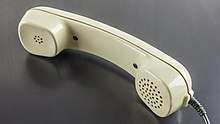Handset


A handset is a component of a telephone that a user holds to the ear and mouth to receive audio through the receiver and speak to the remote party via the built-in transmitter.
In earlier telephones the transmitter was mounted directly on the telephone itself, which was attached to a wall at a convenient height or affixed to a desk stand.
Until the advent of the cordless telephone, the handset was usually wired to the base unit, typically by a flexible tinsel wire.
The handset of a cordless telephone contains a radio transceiver which relays communication via a base station that is wired to the telephone line. A mobile phone does not require a base station and communicates directly with a cell site in specially designated frequency bands.
Handset symbol
| Wikimedia Commons has media related to Handset icons. |
A graphic symbol that designates a handset is used on cordless and mobile phones to specify placing or ending a telephone call. Usually a button with green upright (off-hook) handset icon ![]()
![]()
See also
References
- ↑ Lindholm, Christian; Keinonen, Turkka; Kiljander, Harri (2003-06-22). Mobile Usability: How Nokia Changed the Face of the Mobile Phone: How Nokia Changed the Face of the Mobile Phone. McGraw Hill Professional. ISBN 9780071429108.
- Sajal K. Das, John Wiley & Sons (April 2010) "Mobile Handset Design ", ISBN 978-0-470-82467-2 .